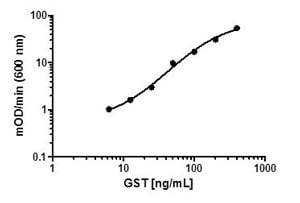GST tag ELISA Kit (ab126581)
Key features and details
- Sensitivity: 1 ng/ml
- Sample type: Cell Lysate
- Detection method: Colorimetric
- Assay type: Sandwich (quantitative)
Overview
-
Product name
GST tag ELISA Kit -
Detection method
Colorimetric -
Precision
Intra-assay Sample n Mean SD CV% Overall 8.5% Inter-assay Sample n Mean SD CV% Overall 4% -
Sample type
Cell Lysate -
Assay type
Sandwich (quantitative) -
Sensitivity
1 ng/ml -
Assay duration
Multiple steps standard assay -
Product overview
Abcam’s Gluthathione S-Transferase (GST) in vitro ELISA (Enzyme-Linked Immunosorbent Assay) kit is designed for the accurate quantitative measurement of GST tagged protein expression in cell extracts or after purification.
The assay employs a GST specific antibody coated onto a well plate strips. Standards and samples are pipetted into the wells and GST present in the sample is bound to the wells by the immobilized antibody. The wells are washed and a primary anti- GST detector antibody is added. After washing away unbound detector antibody an HRP-conjugated secondary detector antibody (HRP Label) specific for the primary detector antibody is pipetted to the wells. The wells are again washed, a TMB substrate solution is added to the wells and color develops in proportion to the amount of GST bound. The developing blue color is measured at 600 nm. Optionally the reaction can be stopped by adding hydrochloric acid which changes the color from blue to yellow and the intensity can be measured at 450 nm.
-
Notes
Typical working ranges
GST (pure protein) 1 – 200 ng/mL
GST fusion protein 6 – 400ng/mL
Gluthathione S-transferase (GST) is a 26 kDa protein typically used as a fusion partner of recombinant proteins to increase the level of protein expression in bacterial systems, enhance solubility, protect from proteolysis, improve folding and allow purification by affinity chromatography on gluthathione resin.
This GST ELISA Kit is an enzyme immunoassay developed for the sensitive detection and quantitation of GST or GST fusion proteins in cells samples or purified tagged proteins. The quantity of GST can be determined in lysates or intermediate purification fractions by comparing their absorbance with that of a known recombinant GST standard curve. The kit has a detection sensitivity limit of 1 ng/mL of GST. Each kit provides sufficient reagents to perform up to 96 assays including standard curve and GST fusion proteins.
Abcam has not and does not intend to apply for the REACH Authorisation of customers’ uses of products that contain European Authorisation list (Annex XIV) substances.
It is the responsibility of our customers to check the necessity of application of REACH Authorisation, and any other relevant authorisations, for their intended uses. -
Platform
Microplate
Properties
-
Storage instructions
Store at +4°C. Please refer to protocols. -
Components 1 x 96 tests 10X Blocking Buffer 1 x 6ml 10X GST Detector Antibody 1 x 700µl 10X HRP Label 1 x 1ml 20X Buffer 1 x 20ml Extraction Buffer 1 x 15ml GST Microplate (12 x 8 antibody coated well strips) 1 unit GST Standard 1 vial HRP Development Solution 1 x 6ml -
Research areas
-
Relevance
GST (Glutathione S-Transferase) is a 26kDa protein encoded by the parasitic helminth Schistosoma japonicum and widely used in the pGEX family of GST plasmid expression vectors as a fusion protein with foreign proteins. -
Alternative names
- Glutathione S Transferase
- Glutathione S-transferase class-mu 26 kDa isozyme
- GST
see all
Images
-
Dynamic Range of a recombinant protein tagged to GST. Recombinant full length protein (Human) p53 with N terminal GST tag (ab43615) was tested in a dilution series from 400 ng/mL to 12 ng/mL using the GST ELISA kit. Background was subtracted from data points prior to log transformation and curve fitting (log-agonist vs. response – variable slope).
-
Example standard curve. GST standard protein was serially diluted from 400 ng/mL to 6 ng/mL. Background was subtracted from data points prior to log transformation and curve fitting (log-agonist vs. response – variable slope). Sensitivity was calculated mathematically to be as low as 1 ng/mL.













